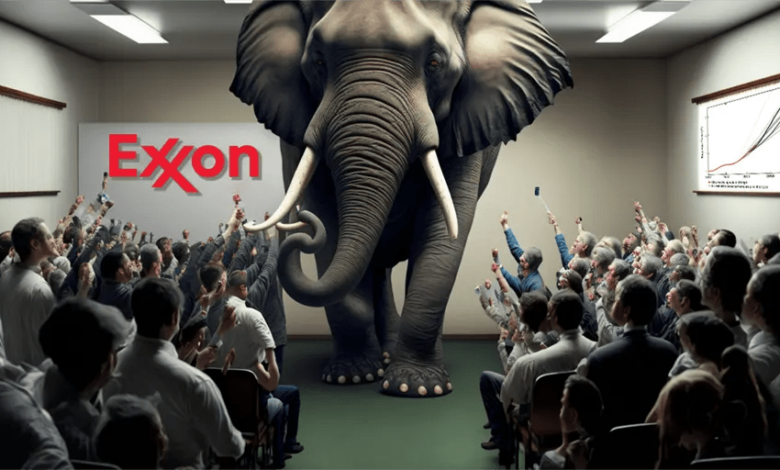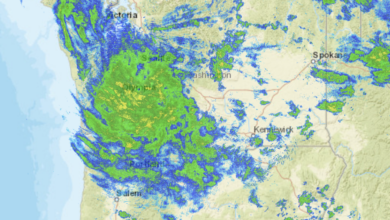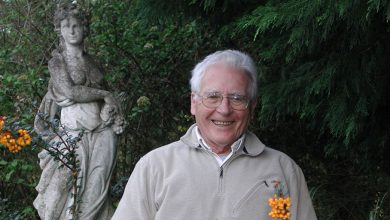What I Learned about What Exxon Knew – Watts Up With That?

Pat Frank
In which “Exxon Knew” is found to be not about knowledge
Accusatory polemics disguised as climate science news is a commonplace these days. Perhaps you, dear reader, have written an email to some science reporter expressing dismay at their unthinking IPCC bias, or offered some correction to purported science. I have done, too, and many times. Typically, there is no reply.
Recently, and above general character, a science reporter constructively replied when I emailed about an article on “climate denial” and “the coal-funded attack on clean energy.” Named climate deniers included John Droz, Steve Milloy — royalty among climate deniers, apparently — and Donald Trump.
Long story short, the reporter sent my comments to Emeritus Prof. Martin Hoffert (New York University), a long-time climate modeler with some impressive early theoretical work. He replied.
This essay is the nuclear fallout emergent from that small spark.
I. Entering the Slough of the Despond.
In 2019, Prof. Hoffert had testified before the House Subcommittee on Civil Rights and Civil Liberties. The subject considered was “Examining the Oil Industry’s Efforts to Suppress the Truth about Climate Change.” The list of evidence-givers included Prof. Naomi Oreskes.
Prof. Hoffert had worked under contract with Exxon climate scientists in the 1980s. In his House Subcommittee testimony, Prof. Hoffert expressed considerable respect for their professionalism and talent. However, his testimony (pdf) included, “… Exxon’s outward facing disinformation and funding of climate change deniers even as our in-house research was predicting just the opposite. They are, as Naomi Oreskes calls them, “Merchants of Doubt” who capitalize on the fact that more people watch TV ads than read scientific literature.“
Along with his critical reply to my reporter interlocutor, Prof. Hoffert sent his Congressional testimony and a copy of (2023) Supran, Rahmstorf, and Oreskes (S-R-O), which declaims proof-positive that, “Exxon Knew.”
The S-R-O (2023) story is that by 1980 Exxon scientists knew as an absolute surety that fossil fuel CO2 emissions would warm the climate, also that by then the scientists had so-informed Exxon management, and also that Exxon management had gone on cynically and with all malign deliberation to lie to the public for the next 40+ years. All for the sake of profits, and the future their own children be damned.
The accusatory center of S-R-O (2023) is their Figure 2; here Figure 1 below, left.
Figure 1, left, compiles the Exxon in-house and published air temperature projections produced by sundry 1970s-2000s-vintage climate models, working on speculative scenarios of future CO2 emissions. The red line is the observed air temperature record, for comparison.
Figure 1, right, shows how the same projections would appear if plotted with all the uncertainty bars that result from the errors in simulated cloud fraction climate models make when simulating the terrestrial climate.
The combination of the entirety of projections with the entirety of their uncertainty bars will ring midnight down on the entirety of the graphic.
Clouds govern the thermal energy flux in the atmosphere. Thermal energy flux governs air temperature. Get the clouds wrong, get the air temperature wrong.
Figure 1: Left, Figure 2 from (2023) Supran-Rahmstorf-Oreskes. The original legend is: “Summary of all global warming projections (nominal scenarios) reported by ExxonMobil scientists in internal documents and peer-reviewed publications (gray lines), superimposed on historically observed temperature change (red).” The projections date from 1977 to 2003. Right: S-R-O (2023) Figure 2 with all the projection uncertainty bars expressing model cloud calibration error added in and plotted together.
Over the entire 1977-2003 time-frame, the lower limit of detection for climate models was >100× larger than the annual perturbation of greenhouse gas emissions. S-R-O (2023) claims that climate models can reveal something that is totally invisible to climate models. This is equivalent to declaiming, ‘Bacterium!‘ on turning a 4× Jeweler’s loupe onto a water droplet.
S-R-O (2023) claim they know now, and in 1977 Exxon scientists and Exxon management knew then, the climate impact of a perturbation that is more than 100-times smaller than the smallest perturbation the climate model can possibly resolve.
A complete inventory of climate model simulation error is very much larger. Also here and here. The climate information transmitted by those Exxon air temperature projections is zero.
Exxon could not have known then and neither could anyone else. Exxon doesn’t know now, either, and neither does anyone else because the total ignorance of 1977 still reigns today.
The S-R-O (2023) graphic in Figure 1, left, also lacks the uncertainty bars of known systematic field measurement error which would stretch the projection black-out curtain back over the observed temperatures. S-R-O (2023) Figure 2 would then correctly display the climate information actually available.
II. In which Exxon reveals what it knew.
The Exxon documents on which S-R-O (2023) rely are conveniently collected at the Climate Files site created and maintained by the Climate Investigations Center. Reading them, one is struck by the professional caution of the Exxon scientists. They wrote plainly about the contemporaneous lack of knowledge. About the ignorance (in 1977) of whether increasing atmospheric CO2 is due to fossil fuel emissions or to forest clearing. About climate models that needed lots of work and were unable to predict the effect of our CO2 emissions on the climate.
A 29 January 1980 internal letter from Walter Eckelmann, Exxon’s Deputy Manager of the Exxon Science and Engineering Department, to Morey O’Loughlin on the Exxon board, noted that, “Science & Technology feels that the build-up of carbon dioxide in the atmosphere is a potentially serious problem requiring the results of a huge world-wide research effort before quantitative predictions can be reached on the probabilities and timing of world climate changes.“
“Potentially” and “huge worldwide research effort,” capture the significance. They didn’t know and much needed doing to find out.
Despite banal partisan avowals to the contrary, no one precociously knows future knowledge.
Mr. Eckelmann went on to say that the effort is beyond the resources of any one company (i.e., Exxon]. He further stated that Exxon had an on-going annual $600k research program dedicated to the CO2-climate problem, and was also funding CO2-climate work at the Marine Biological Lab at Woods Hole and the Scientific Committee on Problems of the Environment (SCOPE), at $20k each per year.
M.B. Glaser was the manager of Exxon’s Environmental Affairs Program. His 1982, “The CO2 “Greenhouse” Effect” (pdf) summarized the situation in an eminently sensible way: “Making significant changes in energy consumption patterns now to deal with this potential problem and all the scientific uncertainties would be premature in view of the severe impact such moves could have on the world’s economies and societies.”
And this: The participants of a AAAS-DOE workshop on the societal and institutional responses to an increase in CO2, “felt that society can adapt to a CO2 increase within economic constraints that will be existing at the time. Some adaptive measures that were tested would not consume more than a few percent of the gross national Product estimated in the middle of the next century.“
In his 1984 report about the Exxon corporate research program on climate and CO2, A. J. Callegeri wrote that,
“· Models are being used to explore physical effects (scenarios) and as a predictive tool.
-Carbon cycle modeling to determine fate of fossil-fuel CO2 emissions.
· Validity of models not established.
-Complexity of carbon cycle and climate system require many approximations and parameterizations.
-Geological and historical data are inadequate for validation of models.”
Sound familiar? Callegeri’s points are still completely true today, nearly 40 years later.
In December 2000 Exxon climate scientist Brian Flannery wrote to Lloyd Keigwin (pdf), of 1996 Sargasso Sea fame, in dismay at the misrepresentation of both his position and of Exxon’s support of climate science. The letter is well worth reading. The negation of Naomi Oreske’s Exxon Knew accusations could not be more explicit.
In short, the plain evidence is that Exxon did not know and was making a good-faith effort to find out.
The entire claim that ‘Exxon Knew’ is completely reliant upon the unspoken, wrong, and utterly fatuous embrace of climate models — even their 1977 incarnations — as truth-machines. God’s lips to their terminals-become-flat-screens.
Exxon knew that they didn’t know and that nobody else knew, either (and still don’t).
III. In which Supran, Rahmstorf, and Oreskes reveal what they did not know in 2023.
Reading S-R-O (2023), I became curious about their Figure 1b (below). The black part of Figure 1b dates back to 1977. In July that year it was vugraph #11 in a presentation made by J. F. Black to the Exxon Corporation Management committee. J. F. Black was a science advisor to Exxon.
J. F. Black gave his presentation 5 years before Neftel, et al., published the first ice-core CO2/δ18O record. So I was curious about the origin of the Figure 1b 150,000-year temperature record. And how were deep-time air temperatures assigned in 1977?
Figure 2: S-R-O (2023) Figure 1b. The black line and axes, complete with smudging, are J. F. Black’s 1977 vugraph #11. The red line is a smoothed, “Earth system model simulation (Ganopolski and Brovkin (2017)) of the last 150,000 years driven by orbital forcing only, with an appended moderate anthropogenic emissions scenario.” S-R-O (2023) Supporting Information (pdf).
So, how were the Figure 1b Fahrenheit temperatures (left ordinate) assigned in 1977? S-R-O cites Figure 1b to J. J. M. Mitchell, Carbon dioxide and future climate. Environmental Data Service (March): 3–9 (1977), but the S-R-O link is to a Department of Energy abstract, not to the paper.
After some effort I found the EDS journal archive (42 MB pdf). Mitchell’s article appears in the March 1977 issue, pp. 3-9. S-R-O (2023) Figure 1b started life as Figure 5 in Mitchell (1977).
But Mitchell did not provide a citation for his Figure 5, either. Nor did he say how the temperature scale was assigned. Where did all that come from?
Long story short, I searched the literature for a proxy that might have provided data for Mitchell in 1977. That quest led to J. D. Hays, et al., (1976) “Variations in the Earth’s Orbit: Pacemaker of the Ice Ages.”
Hays (1976) reported foraminiferal δ18O from two deep sea sediment cores obtained from the southern Indian Ocean, (near 45° S latitude; 85° E longitude). Hays (1976) also used radiolarian assemblages to estimate summer subantarctic sea surface temperatures (SST ±3 C; 95% CI) at the core sites.
Hays (1976) would have been the best knowledge available in 1977 when Mitchell wrote his paper and when Black made his 1977 presentation to Exxon.
But it gets complicated. Figure 3 shows that the Mitchell (1977) temperature graphic looks very much like stage 1-6 of the Hays (1976) Figure 9A foraminiferal δ18O series.
Figure 3: Extract of the first 150 kYr Before the Present of the d18O series from Figure 9A of Hays, et al., (1976). The abscissa is reversed relative to S-R-O (2023) Figure 1b.
In fact, Mitchell Figure 5 appears to be a hand-drawn reproduction of Hays (1976) Figure 9A..
Figure 4 below is S-R-O (2023) Figure 1b and the Hays (1976) foraminiferal δ18O over the same time range and with scaled abscissas. The vertical red lines position the two graphics. The year ticks all line up nicely. The vertical green lines centered on the Hays (1976) δ18O features line up well with Mitchell (1977).
Figure 4: S-R-O (2023) Figure 1b lined up with my digitized version of Hays (1976) foraminiferal δ18O. The vertical green lines traverse the centers of the Mitchell (1977) features in black and line up well with Hays δ18O. The features of the simulation used by S-R-O (2023) (red) do not align with Mitchell, 1977 or Hays (1976) at -130 kyr and “Today”.
Hays (1976) also included an equally extensive SST series, but Mitchell (1977) Figure 5 does not match it. Figure 5 below is S-R-O (2023) Figure 1b and the Hays (1976) radiolarian SST series, over the same annual range and with the abscissas in registry. The vertical green lines indicate good time-registry between the radiolarian SSTs and the simulation used in S-R-O (2023) (red).
However, the shapes and intensities of the Hays (1976) SSTs do not match the Mitchell (1977) features. The S-R-O (2023) simulation matches the timing of the Hays (1976) SST series, but between 25-105 kYr bp the shapes and intensities are a mismatch.
Figure 5: The S-R-O (2023) Figure 1b aligns well with the time sequence of the Hays (1976) radiolarian SST series. The vertical green lines traverse the centers of the SST features. Mitchell (1977) aligns positionally with Hays (1976) between -105 kYBP and -20kYB, but the intensities and structures are disparate. S-R-O (2023) (red) aligns with the Hays (1976) SST time series, but not with the shapes or intensities. Far right, bottom is the first 150 kYr of the published Hays (1976) foraminiferal δ18O series. The similarity of both S-R-O (2023) and Mitchell (1977) with Hays (1976) δ18O, but not with Hays (1976) SST is obvious by inspection.
Both Mitchell (1977) and S-R-O (2023) obviously correspond much more closely with the shape of the Hays (1976) δ18O series, than with the Hays SST series.
It seems neither Supran, Rahmstorf, nor Oreskes did any careful source-check of Mitchell (1977). S-R-O evidently didn’t realize in 2023 that Mitchell (1977) had re-purposed Hays (1976) 150 kYr Indian Ocean δ18O series to use as a global air temperature series.
It also seems likely that S-R-O did not know that Mitchell (1977) Figure 5 is, by every indication, a hand-drawn cartoon of the Hays (1976) δ18O curve.
Oops.
IV. In which the temperature bug bites.
So, how did Mitchell assign temperatures to his Figure 5? Mitchell had clearly read Hays (1976). Hays (1976) in turn estimated the glacial temperature to be about 6±1.5 C colder than now, which equates to -10.8±2.7 °F.
Very likely Mitchell (1977) got the temperature scale on his re-purposed δ18O Figure 5 series from the glacial estimate in Hays (1976).
In this light, Mitchell converted the Hays (1976) Celsius into Fahrenheit, estimated the present global mean temperature to be 60 F (15.6 C), and used the Hays (1976) estimate to get the glacial minimum. Mitchell’s 60 °F modern period is the dashed line, and the last glacial minimum at -25k years is about 9 °F colder. The Mitchell Fahrenheit range is about 49-65 °F. The Fahrenheit scale is just the linear interpolation.
The Hays (1976) radiolarian proxy temperature has a very wide statistical uncertainty (95% CI = ±3 C). Hays (1976) estimated the SST of the southern Indian Ocean where the sedimentary cores were drilled. It was not a global average of SST.
Mitchell apparently assigned the re-purposed the Hays (1976) δ18O series to indicate global average air temperature. We don’t know why. Perhaps he thought it reasonable. Regardless, his assignment was uncritically accepted by S-R-O (2023) when they did the work for Figure 1b.
The emergent mystery is how Stefan Rahmstorf and his applied Earth System Model air temperature simulation exactly reproduced a hand-drawn cartoon of 150,000 years of Indian Ocean δ18O re-branded as a speculative global air temperature.
Repeat: Stefan Rahmstorf applied the Earth System Model simulation to hand-drawn cartoon wiggles of an Indian Ocean δ18O doppelganger as though they were physically real global air temperatures.
V. In which the benthic despond is revealed.
It gets worse. S-R-O (2023) represented that their Figure 1b (red) Earth System Model simulation was published in(Ganopolski and Brovkin (2017)) (see the legend to Figure 2 above). But that paper includes no air temperature simulations. The S-R-O (2023) simulation is actually found in Figure 1 of Ganopolski and Calov, 2011, who used the same CLIMBER 2 Earth System model.
Ganopolski and Calov (G-C) (2011) simulated 800,000 years of Antarctic and Greenland air temperature anomalies. S-R-O (2023) used the Antarctic simulation in their Figure 1b overlay of Mitchell (1977) Figure 5.
Figure 6 below compares the Antarctic simulation of G-C (2011) with Figure 1b of S-R-O (2023). The comparison is a bit cluttered, but reveals a depth of unscientific benthos that either escaped the notice of, or perhaps was sailed over by, Profs. Supran, Rahmstorf, and Oreskes.
Figure 6: Top, Figure 1b of Supran, Rahmstorf and Oreskes (2023), with selected features annotated. Bottom, Figure 1e Ganopolski and Calov, 2011, first 150kYr of the “Antarctic temperature anomaly,” simulation selectively annotated and with an added 150 kYr bp tick. The top and bottom abscissas are in registry. The red vertical lines fix the comparison at the paleo-minimum and the modern maximum. The vertical green lines traverse the centers of major G-C (2011) features. The horizontal purple lines mark out features that have been temperature-annotated.
The selected temperatures were extracted from using mm ruler measurements. Their precision is not better than ±0.2 C. Figure 6 shows good correspondence between the G-O (2011) Antarctic simulation and the S-R-O (2023) Figure 1b overlay. The G-O (2011) Greenland temperature anomaly series is structurally similar but much colder (Table 1).
Table 1: Non-Identical Temperatures of the Identical G-C (2011) Ant. and S-R-O 2023 simulations.
| kYr bp | Temp. (C) G-C (2011) Ant. | Temp. (C) S-R-O (2023) | Temp. (C) G-C (2011) Grnld |
|---|---|---|---|
| -127 | 1.4 | 0.8 | -0.2 |
| -99 | -2.8 | -0.7 | -4.0 |
| -82 | -2.8 | -1.5 | -4.0 |
| -56 | -5.1 | -2.7 | -9.2 |
| -22 | -7.6 | -4.8 | -21.9 |
| 0 | -0.2 | -0.1 | -0.6 |
S-R-O (2023) Supporting Information described the simulation in Figure 1b, absent the technicalese, as: “The observations in panel 1b of Fig. 1 reflect a smoothed (LOWESS) Earth system model simulation of the last 150,000 years driven by orbital forcing only, with an appended moderate anthropogenic emissions scenario.“
S-R-O (2023) itself described Figure 1b as, “a smoothed Earth system model simulation of the last 150,000 years.” and, “a smoothed Earth system model simulation of the last 150,000 years driven by orbital forcing only, with an appended moderate anthropogenic emissions scenario.“
And the S-R-O (2023) extended description: “Panel 1b of Fig. 1 is a graph of the global warming “effect of CO2 on an interglacial scale” originally published by climate scientist J. Murray Mitchell Jr. in March 1977 and reproduced by Exxon scientist James Black in a private briefing to the Exxon Corporation Management Committee 4 months later. … [O]verlaying the original graph with the temperatures simulated by a modern Earth system model (in red) shows that Exxon scientists were accurate in warning their superiors of the prospect of a “carbon dioxide induced ‘super-interglacial,’” as Mitchell Jr. termed it, that would render Earth hotter than at any time in at least 150,000 years.”
The language of S-R-O (2023) directly implies that the Mitchell (1977) Figure 5 graphic represented a global air temperature record.
However, Hays (1976) described the re-purposed δ18O series (p. 1122) as, “Down-core variations in δ18O reflect changes in oceanic isotopic composition, caused primarily by the waxing and waning of Northern Hemisphere ice sheets. Thus, the δ18O in our subantarctic cores is a Northern Hemisphere climatic record.“
In other words, the δ18O series reflects large-scale swings in the climate over geological time. Not global air temperature.
Foraminiferal δ18O remains problematic today for use as an SST proxy. Waelbroeck, et al., (2005) state, “The large discrepancy between δ18O values of living and recent fossil foraminifera highlights the difficulty in reconstructing past surface conditions based on fossil planktonic foraminifera δ18O.
VI. In which the Mariana Trench of Despond is plumbed.
Given that the S-R-O (2023) and G-C (2011) Antarctic anomaly simulations are reported to be identical, one should expect identical anomaly temperatures. But Figure 6 and Table 1 show that the anomaly temperatures that should be identical are in fact very different. The S-R-O (2023) temperatures are all smaller than the G-C (2011) homologues, except at 0 kYr bp. How did that happen?
Stefan Rahmstorf is the climate modeler of the group. He has likely walked into quicksand. But I want to be very careful with my language here.
The only reasonable explanation for the smaller temperature differences within the S-R-O (2023) Figure 1b overlay relative to the G-C (2011) simulation, is that the G-C simulation was compressed into artificial correspondence with the Mitchell (1977) hand-drawn, low-precision, thermally speculative, physically ambiguated, version of the Hays (1976) southern Indian Ocean foraminiferal δ18O series.
The Figure 1b red overlay is not an accurate reproduction of the G-O (2017)(sic) simulation as it was represented to be. From G-C (2011} (the evident source), the red overlay has been compressed into correspondence, rendering false physical meaning to a speculative cartoon and lending an entirely spurious analytical credit to Mitchell (1977). It is very hard to imagine how this misconstruction was inadvertent.
Figure 1b does not show that Exxon knew (which we already know to a certainty that it did not and indeed could not). Exxon has been indicted on spurious evidence.
The Figure 1b overlay instead shows that S-R-O did not know the speculative standing of Mitchell (1977) Figure 5. They were careless. They did not track Mitchell (1977) Figure 5 back to its origin. They were evidently uncurious about its provenance. And they employed it to their purpose despite all.
Perhaps Profs. Supran, Rahmstorf, and Oreskes should be asked how that happened.
Figure 1b is paradigmatic of the entire corpus of AGW-related consensus climatology.
VII. In which a summary finding of Exxon-Knewism is rendered.
- Exxon’s climate models did not foretell future temperature.
- Exxon’s scientists knew Exxon’s climate models did not foretell future temperature.
- Exxon’s managers knew Exxon’s scientists knew Exxon’s climate models did not foretell future temperature.
- Exxon corporately made a good-faith effort to understand CO2-climate connections.
- Exxon management funded independent research into CO2-climate connections.
- Exxon didn’t know.
- Exxon managers and scientists knew that Exxon didn’t know.
- Geoffrey Supran, Stefan Rahmstorf and Naomi Oreskes view all climate models as truth-machines.
- No matter the plain evidence, Geoffrey Supran, Stefan Rahmstorf and Naomi Oreskes do not know that Exxon did not know. At best.
- Supran, Rahmstorf, Oreskes (2023) is wrong in every important particular.
VIII. In which judgments are made and conclusions are drawn.
- Supran, Rahmstorf, Oreskes (2023) Figure 1b is minimally a soaring monument to careless tendency.
- The S-R-O (2023) Exxon Knew indictment dismally failed its evidentiary hearing.
- Supran, Rahmstorf, Oreskes (2023) passed the conscious muster with editors and reviewers of Science Magazine.
- S-R-O (2023) is akin to a journalistic show-trial.
- Science Magazine, in prosecuting the indictment, is administratively akin to Andrey Vyshinsky.
- Such is the culture now in possession of establishment journals.
IX. In which my hat is off to the indomitable Russell Cook and may this work find some utility.




